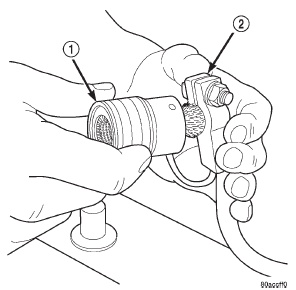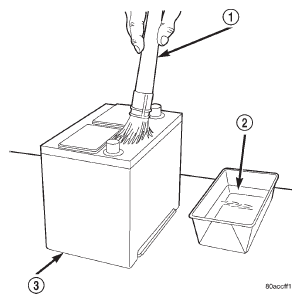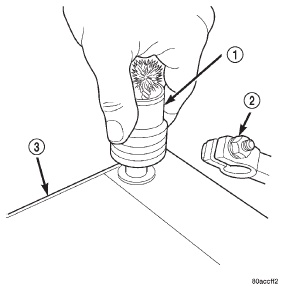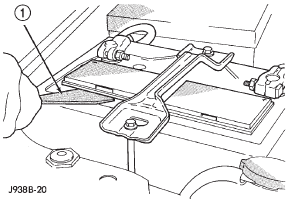Jeep Cherokee (XJ): Cleaning and inspection
BATTERY
The following information details the recommended cleaning and inspection procedures for the battery and related components. In addition to the maintenance schedules found in this service manual and the owner's manual, it is recommended that these procedures be performed any time the battery or related components must be removed for vehicle service.
CLEANING
(1) Clean the battery cable terminal clamps of all corrosion. Remove any corrosion using a wire brush or a post and terminal cleaning tool, and a sodium bicarbonate (baking soda) and warm water cleaning solution (Fig. 24).
(2) Clean the battery tray and battery hold down hardware of all corrosion. Remove any corrosion using a wire brush and a sodium bicarbonate (baking soda) and warm water cleaning solution. Paint any exposed bare metal.
(3) If the removed battery is to be reinstalled, clean the outside of the battery case and the top cover with a sodium bicarbonate (baking soda) and warm water cleaning solution using a stiff bristle parts cleaning brush to remove any acid film (Fig.
25). Rinse the battery with clean water. Ensure that the cleaning solution does not enter the battery cells through the vent holes. If the battery is being replaced, refer to Battery in the index of this service manual for the location of the factory-installed battery specifications. Confirm that the replacement battery is the correct size and has the correct ratings for the vehicle.
(4) Clean the battery thermoguard with a sodium bicarbonate (baking soda) and warm water cleaning solution using a stiff bristle parts cleaning brush to remove any acid film.

Fig. 24 Clean Battery Cable Terminal Clamp - Typical
1 - TERMINAL BRUSH
2 - BATTERY CABLE

Fig. 25 Clean Battery - Typical
1 - CLEANING BRUSH
2 - WARM WATER AND BAKING SODA SOLUTION
3 - BATTERY
(5) Clean any corrosion from the battery terminal posts with a wire brush or a post and terminal cleaner, and a sodium bicarbonate (baking soda) and warm water cleaning solution (Fig. 26).

Fig. 26 Clean Battery Terminal Post - Typical
1 - TERMINAL BRUSH
2 - BATTERY CABLE
3 - BATTERY
INSPECTION
(1) Inspect the battery cable terminal clamps for damage. Replace any battery cable that has a damaged or deformed terminal clamp.
(2) Inspect the battery tray and battery hold down hardware for damage. Replace any damaged parts.
(3) Slide the thermoguard off of the battery case.
Inspect the battery case for cracks or other damage that could result in electrolyte leaks. Also, check the battery terminal posts for looseness. Batteries with damaged cases or loose terminal posts must be replaced.
(4) Inspect the battery thermoguard for tears, cracks, deformation or other damage. Replace any battery thermoguard that has been damaged.
(5) Inspect the electrolyte level in the battery. Use a putty knife or another suitable wide flat-bladed tool to pry the cell caps off (Fig. 27). Do not use a screwdriver.
Add distilled water to each cell until the liquid reaches the bottom of the vent well. DO NOT OVERFILL.

Fig. 27 Removing Battery Cell Caps - Typical
1 - PUTTY KNIFE
(6) Inspect the battery built-in test indicator sight glass for an indication of the battery condition. If the battery is discharged, charge as required. Refer to Battery in the index of this service manual for the location of the proper battery diagnosis and testing procedures for more information on the use of the battery built-in test indicator. Also refer to Battery Charging in the index of this service manual for the location of the proper battery charging procedures.
Other materials:
Maintenance schedules
SERVICE PROCEDURES
DESCRIPTION
Service and maintenance procedures for components
and systems listed in Schedule "A" or "B" can
be found by using the Group Tab Locator index at
the front of this manual. If it is not clear which
group contains the information needed, refer to the
index at the b ...


